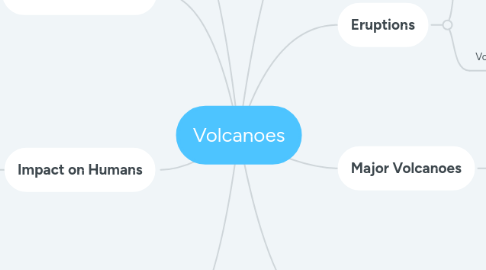Volcanoes
저자: Stakeholder Map


1. Understanding Volcanoes
1.1. Definition
1.2. How they form
1.2.1. Tectonic plate boundaries
1.2.2. Hotspots
2. Volcano Structures
2.1. Magma Chamber
2.2. Vents
2.3. Crater
2.4. Lava flow
3. Impact on Humans
3.1. Hazards
3.1.1. Lava Flows
3.1.2. Pyroclastic Flows
3.1.3. Ash Fall
3.1.4. Lahars
3.1.5. Tsunamis
3.1.6. Gas emissions
3.2. Disasters
3.3. Benefits
3.3.1. Geothermal energy
3.3.2. Tourist attractions
3.3.3. Fertile soils
4. Volcano Monitoring and Prediction
4.1. Seismic Monitoring
4.2. Gas Emissions
4.3. Ground Deformation
4.4. Thermal Monitoring
5. Types of Volcanoes
5.1. Shield Volcanoes
5.1.1. Example: Mauna Loa
5.2. Composite or Stratovolcanoes
5.2.1. Example: Mount Fuji
5.3. Lava Domes
5.3.1. Example: Lassen Peak
5.4. Cinder Cones
5.4.1. Example: Paricutin
6. Eruptions
6.1. Types of Eruptions
6.1.1. Effusive
6.1.2. Explosive
6.2. Volcanic Materials
6.2.1. Lava
6.2.2. Pyroclastics
6.2.2.1. Ash
6.2.2.2. Lapilli
6.2.2.3. Bombs
6.2.2.4. Blocks
7. Major Volcanoes
7.1. Ring of Fire
7.2. Yellowstone
7.3. Mount Vesuvius
7.4. Krakatoa
8. Volcano Research
8.1. Volcanology
8.2. Famous Volcanologists
8.2.1. Harry Glicken
8.2.2. Haroun Tazieff
8.2.3. Katia and Maurice Krafft
8.3. Research Institutions
8.3.1. United States Geological Survey (USGS)
8.3.2. Institute for Volcanology and Geodynamics (IVGD)
8.3.3. Hawaiian Volcano Observatory (HVO)
